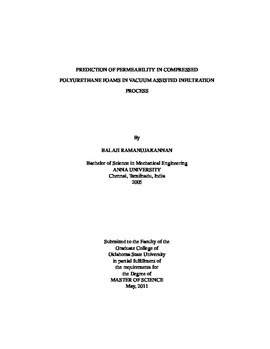| dc.contributor.advisor | Singh, Raman Pal | |
| dc.contributor.author | Ramanujakannan, Balaji | |
| dc.date.accessioned | 2014-04-17T19:53:51Z | |
| dc.date.available | 2014-04-17T19:53:51Z | |
| dc.date.issued | 2011-05-01 | |
| dc.identifier.uri | https://hdl.handle.net/11244/10040 | |
| dc.description.abstract | Foams used for radio-frequency(RF) and acoustic shielding were treated with carbon black and cut into pyramidal blocks for better absorption characteristics. The general manufacturing process involves immersion of polyurethane foam blocks in a bath of carbon black solution and fire retardants followed by cutting the blocks into desired pyramidal shapes. The immersion process has inbuilt conductivity variation and impacts the absorption properties apart from resulting in significant quantity of scrap. These scraps needs to be treated chemically before being disposed to landfills which significantly increases overhead costs. A potential alternative to the existing fabrication technique was proposed and hence vacuum assisted infiltration (VAI) was developed successfully for infiltration of carbon black mixture into foams. With VAI on foams being the preliminary motivation, this work predicts the variation of local permeability along the cross-section of the foam under compression. These permeability values can be used to model the fluid flow using computational fluid dynamics to determine the location of the inlet and outlet ports in VAI process to achieve homogenous infiltration. An extended version of the Darcy's flow equation for porous media forms the basis of the governing equation. As the infiltration happens in a compressed block of foam, Permeability(K) varies with compression and is dependent on strain. Uniaxial compression experiments were carried out to obtain the stress-strain curves on a cubical foam block and this curve was fit to Ogden's material model for elastomeric foams in Matlab to obtain material parameters. This experiment was duplicated in ABAQUS to validate the predicted material parameters. These material parameters were then used to simulate uniaxial compression of pyramidal blocks in ABAQUS for determining local strains. Variation in local permeability was determined from local strains across the height of the compressed block using the equations developed by Hilyard and Collier. | |
| dc.format | application/pdf | |
| dc.language | en_US | |
| dc.publisher | Oklahoma State University | |
| dc.rights | Copyright is held by the author who has granted the Oklahoma State University Library the non-exclusive right to share this material in its institutional repository. Contact Digital Library Services at lib-dls@okstate.edu or 405-744-9161 for the permission policy on the use, reproduction or distribution of this material. | |
| dc.title | Prediction of Permeability in Compressed Polyurethane Foams in Vacuum Assisted Infiltration Process | |
| dc.type | text | |
| dc.contributor.committeeMember | Vaidyanathan, Ranji | |
| dc.contributor.committeeMember | Sallam, Khaled A. | |
| osu.filename | Ramanujakannan_okstate_0664M_11303.pdf | |
| osu.college | Engineering, Architecture, and Technology | |
| osu.accesstype | Open Access | |
| dc.description.department | Mechanical & Aerospace Engineering | |
| dc.type.genre | Thesis | |
| dc.subject.keywords | anechoic chamber | |
| dc.subject.keywords | modeling non uniform foam blocks | |
| dc.subject.keywords | ogden's model | |
| dc.subject.keywords | permeability | |
| dc.subject.keywords | pyramidal foam blocks | |
| dc.subject.keywords | vacuum assisted infiltration | |
